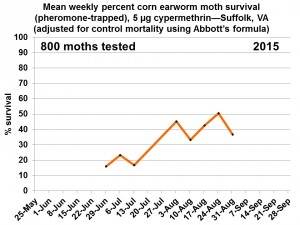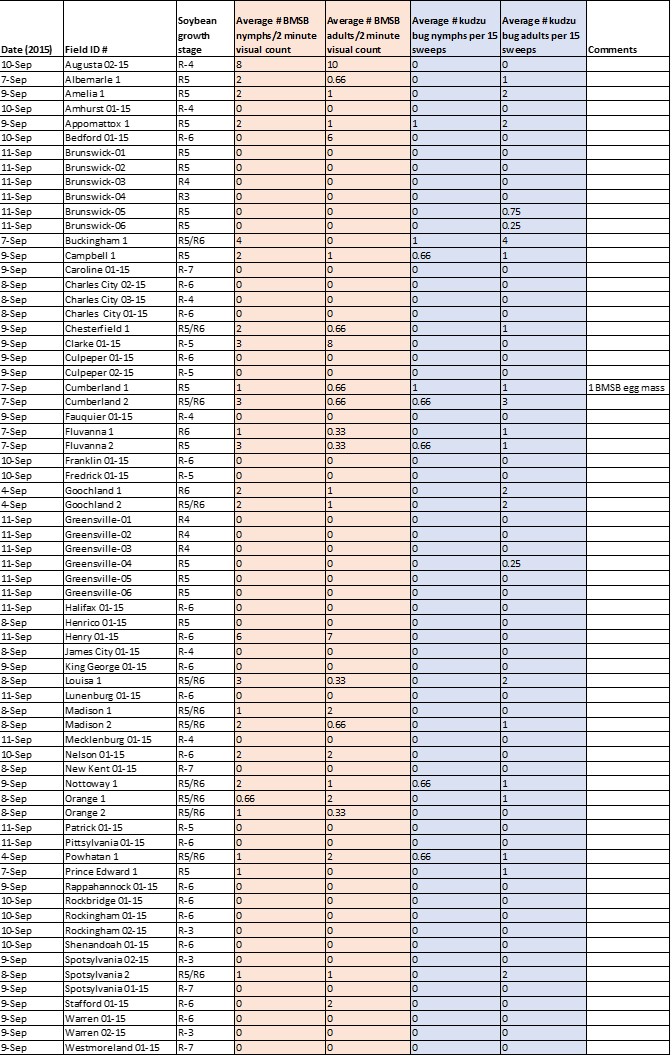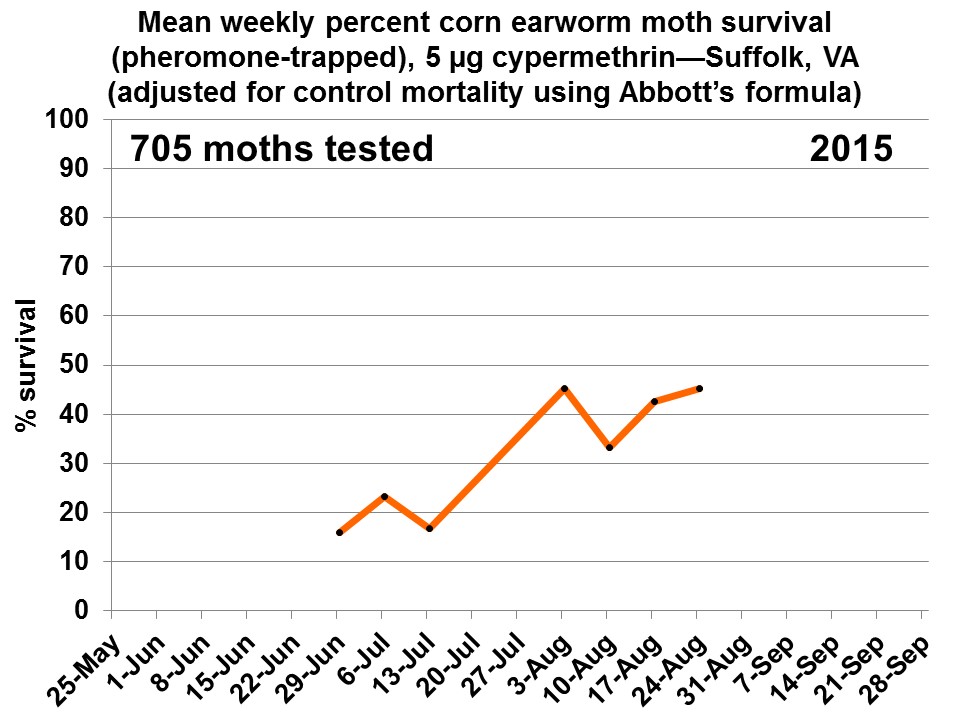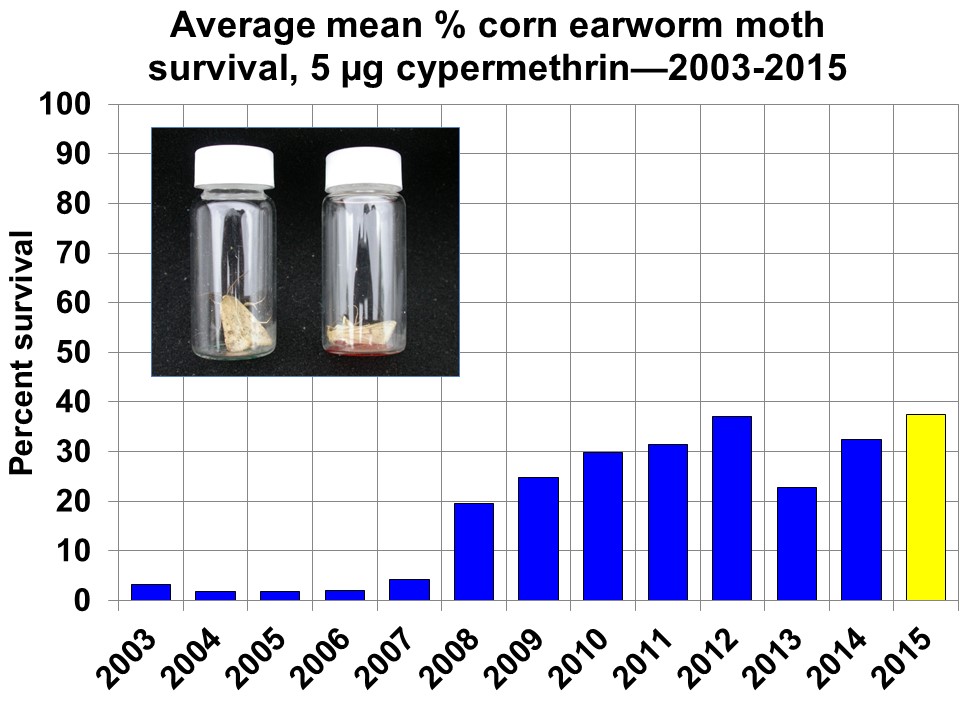Another Virginia county has been found with sugarcane aphid in sorghum. Please see the attachment for more details. SCA_advisory_Sep_18_2015
Category Archives: Insect
Sugarcane aphids found in sorghum field in Suffolk, Virginia
Dr. Ames Herbert confirmed the presence of sugarcane aphids, Melanaphis sacchari, in a sorghum field at the Tidewater Agricultural Research and Extension Center in Suffolk, Virginia, on Sep. 17, 2015. Sugarcane aphid spreads as winged adults on wind and storm fronts so infestations can spread rapidly—so to be on the safe side, sorghum fields should be scouted.
There are several other aphid species that can infest sorghum but sugarcane aphid can be differentiated from the others being smooth, cream yellow, with two, short dark cornicles (“tailpipes”) on the hind end.
Research by Mike Brewer, Texes AgriLife, and David Kerns, LSU, has provided the most up-to-date Econominc Injury Level (EIL) of 50 to 125 aphids per leaf at sorghum prices of $4/bu; and the currently recommended Economic Threshold (when the insecticide needs to be applied to prevent the population from reaching the EIL) of 25 – 30% infested plants with 50 aphids per leaf.
After heading, according to work in other states, one of the more effective insecticide products is Sivanto (Bayer CropScience). Please refer to the Section 2(ee) Recommendation for the lower (but effective) rate of Sivanto @ 4-7 oz/A here: http://www.cdms.net/ldat/ldC4K023.pdf (please take note of the pre-harvest intervals and other directions found in the Section 2(ee)).
BMSB and kudzu bug soybean scouting report update for Sep. 16, 2015
Scouts Ed Seymore and Jamie Hogue have found multiple soybean fields in Virginia this week (early to mid-September) with threshold levels of brown marmorated stink bug (BMSB)–please refer to the figure for locations and numbers, noting that the columns for BMSB nymphs and BMSB adults need to be added together for calculating threshold numbers (more on that below). Of course this is just a small sample of the fields out there, but their reports stress the need to scout your fields, especially those fields at the late R4 growth stage (full pod, where pods are 3/4-inch [2-cm] long at one of the four uppermost nodes) and at R5 (beginning seed, where seed is 1/8-inch [3-mm] long in the pod at one of the four uppermost nodes on the main stem).
Due to their concentrations along field edges, BMSB should be sampled using 2-minute visual counts, 15-sweeps with a net, or beat cloth (wide rows only), by walking 10-20 feet into a field, taking several samples in different parts of the field edge, and determining the average. The thresholds for BMSB (adults + medium and large nymphs) in soybean, where BMSB is the predominant species, is 3-5 in a 2-minute visual count; 3-5 per 15 sweeps; or 0.5 per row foot using a beat cloth. If a threshold is met, an edge-only insecticide treatment with a labeled pyrethroid, carbamate, or organophosphate at the R5 soybean growth stage can provide high levels of control. As always, please be sure to read and follow the label.
Note that if your sampling finds a mix of stink bug species (e.g., BMSB, green, and brown) throughout the field, use thresholds of 5 per 15 sweeps or 1 per row foot (total all species, adults and nymphs).
Black light trap report for the week ending September 10, 2015
Average black light trap catches this week ranged from 1 to 9 corn earworm moths per night; no brown marmorated stink bugs were captured in the traps. Please see the attached table for more details. BLT_10_Sep_2015
Black light trap report for the week ending August 27, 2015
Average black light trap captures of corn earworm moth ranged from less than one to 20 per night; brown marmorated stink bug captures ranged from zero to almost 4 per night. Numbers were similar to what we saw last week. Please see the attached tables for further details. BLT_Aug_27_2015
Corn earworm/bollworm moth vial test update for Aug. 27, 2015
So far this week we have tested 41 moths, with 37% surviving the 24-hour vial-test exposure to 5 micrograms of the pyrethroid insecticide, cypermethrin. This percentage falls very close to our seasonal average of 39% survival (n = 800 moths tested). The line graph, below, indicates our results to date. 
BMSB and kudzu bug distribution maps for the week ending August 27, 2015
Brown marmorated stink bug and kudzu bug were found in soybean in several additional Virginia counties this week–please refer to the distribution maps below. Fields at or above the BMSB threshold of 3 to 5 total adults + medium and large nymphs in a 2-minute visual count were found in the following counties: Bedford (12 BMSB per sample), Shenandoah (8 BMSB), Nelson (4 BMSB) and Henry (3 BMSB). Thanks to our scouts Ed Seymore and Jamie Hogue, and to ANR Agent Scott Reiter for their reports this week. 

Black light trap captures for the week ending August 20, 2015
Corn earworm moth nightly black light trap catches ranged from 0.1 to 12.1 per night–please see the attached data table for more information. No brown marmorated stink bugs were caught this past week in the black light traps. Thanks to all the Extension Agents for their reports this week. CEW_blt_Aug_20
Corn earworm advisory
The corn earworm moth flight is underway, but is still pretty light compared to past years. Worm numbers are gradually increasing in soybean, peanut, cotton, and sorghum fields, but are still not at economic levels.
Worms are rarely, if ever, an economic threat to peanuts as they feed only on leaves, feed for only a short time, and do not remove enough leaf area to result in any yield loss. So why do most peanut farmers spray their fields for worms when there is no chance that those sprays will improve the yields?
We are finding a few worms in soybean fields, but not many. And, if fields are not in the R5 growth stage (seed forming in the pods), worms are not a threat. They are only a threat when they start eating seed, so if no seed are present, there is no need to treat. If seed are present, a good rule-of-thumb threshold would be to treat if you catch an average of 1 to two per 15 sweeps—but only if seeds are present.
Most cotton, unless very late planted, is mature enough to be safe from worms. At this point in the season, it would be very hard to justify treating most cotton fields for worms.
Sorghum is a different story. Corn earworms are highly attracted to sorghum heads, especially late planted sorghum. For more information on this, read to sorghum insect pest advisory that was just posted.
We are detecting a pretty high level of pyrethroid resistance in the corn earworm moths we are testing. The attached figures show this. With 705 moths tested so far this year, we are seeing an increase in the number surviving with a cumulative average of 37.5 percent survival. From the attached figure, you can see that this is high compared to previous years. Non-pyrethroid insecticides will need to be considered, especially if heavy infestations occur.




